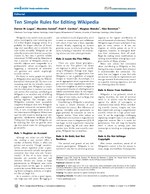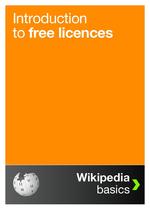Wikipedia training day, Hobart VET

This was a nice easy going day for a group of 11 people entirely new to Wikimedia Foundation projects. Supported by Leigh Blackall and Charles Gregory, the group started Userpages in Wikipedia, looked at the various WMF projects with a particular interest in the Book Creation tools, and at the end of the day started work on projects such as KSiobhan starting a Wikipedia page about the Newdegate Cave, or SapphireC starting a lesson plan for her year 9 class to edit the Huonville High School page. For Fionalowenthal the training day was a chance recover work lost to a deletionist who ruined attempts to start a Wikipedia page for LINC Tasmania (now in user space thanks to Charles' rescue work). It was a fun a relaxed day, ending in a strong sense that the people in the group will continue working in the WMF project spaces, and take their discoveries into their respective work places.
Thanks to PaddyMclaugh and EloiseAnne from Skills Tasmania, and to Chuq from Wikimedia Australia for volunteering their assistance in organising this training day.
Details
[edit]Tuesday the 28th of February 2012
9:30am - 4.00pm
Hobart Polytechnic. 75 campbell street.
Contact: Eloise at mailto:E-learningUnit@education.tas.gov.au or call 03 6233 7333
- 9.30-10 Introductions
- 10-10:30 Create a wiki userpage
- 10:30-11 Morning tea
- 11-12 Review user pages, and copy to Wikipedia
- 12-12.30 Use talk pages
- 12.30-1 Lunch
- 1-2 Create a sandpit page, try formatting
- 2-2.30 Upload and or use images on Commons
- 2.30-3 Afternoon tea
- 3-4 Edit a Wikipedia page
Participants
[edit]- Adrian kelleher (talk) 22:46, 27 February 2012 (UTC)
- Frankieforsyth (talk) 22:49, 27 February 2012 (UTC)
- Chuq (talk) 00:09, 28 February 2012 (UTC)
- SapphireC (talk) 01:17, 28 February 2012 (UTC)
- Cheryl.M.Williams (talk) 01:24, 28 February 2012 (UTC)
- KSiobhan (talk) 01:28, 28 February 2012 (UTC)
- Ninamcmahon2012 (talk) 01:38, 28 February 2012 (UTC)
- Joshua Sproule (talk) 03:29, 28 February 2012 (UTC)
- Fionalowenthal (talk) 04:09, 28 February 2012 (UTC)
- KerrinGrosvenor (talk) 04:14, 28 February 2012 (UTC)
- PaddyMclaugh 04:23, 28 February 2012 (UTC)
- EloiseAnne (talk) 04:24, 28 February 2012 (UTC)
- Leighblackall (talk) 07:20, 28 February 2012 (UTC)
Budget
[edit]- $600 Facilitator 2 nights accommodation and expenses
- $300 Facilitator fee. To be paid by Skills Tasmania
- Travel covered by Kingston training day
See also
[edit]- Wikipedia training day, Kingston Tasmania on the 29th of February, the day after this training day
Examples of educational use of Wikimedia Foundation projects
[edit]- Wikipedia
Introducing Wikipedia
[edit]| User Name | Nice People | Edit Button | Nice Feeling |
|---|---|---|---|
| This video shows some of Wikipedia's contributors, explaining their user names. | This video focuses on the motivations and passion of Wikipedians, and ends with a comment by Wikipedia founder Jimmy Wales about what makes the project special. | This video is a direct invitation by Wikipedians to "click that [edit] button and see what happens". | In this video, Wikipedians talk about the joy of being part of a global community of editors. |
- Why Wikipedians are the Weirdest People on the Internet (YouTube) – a humorous presentation by Wikipedian Steven Walling about the culture of Wikipedia and its editors.
- Wikipedia Vision – an animated map that highlights live edits from users around the world as they happen, demonstrating the global nature of the project.
- wikistream – a visualization showing a stream of edits to the most popular Wikipedia projects.
- Live feed of all edits – a feed that outputs every new change to English Wikipedia, demonstrating the pace of Wikipedia's evolution: 1–2 edits per second. Requires an IRC client to view.
- Wikipedia article traffic statistics – a tool for charting how many hits any given article gets, great for comparing different kinds of articles at different times, e.g., Genetics (in the school year) vs. (in the summer), or YouTube (with weekend spikes) and Simpsons (with spikes when new episodes come out). Students can also use it to see how many people are reading their articles over the course of the class (and beyond).
- Manypedia - a tool for comparing a specific Wikipedia page from a language edition Wikipedia (for example, English) with its equivalent page on another language edition Wikipedia (for example, Arabic), exploiting automatic translation and additional statistics about both pages such as number of edits and editors.
- WikiTrip - a tool for visualizing the animated evolution in time of two kinds of information about the Wikipedians who edited the selected page: their location in the world and their gender.
Mechanics of editing Wikipedia
[edit]These printable PDF documents are designed to be handed out to students, either as part of a packet at the beginning of a Wikipedia assignment, or throughout the term at appropriate points.
- Wiki markup quick reference – This one-page quick reference (included in the Welcome to Wikipedia brochure) helps you to remember the most frequently used wiki markup codes.
- References – This handout explains why references are important, what the expectations for sourcing on Wikipedia are, where to place references, and the basics of adding "ref" tags.
- Reference formatting – This handout explains in more detail how to create footnotes for citing sources, and how to cite the same source multiple times.
- How to get help – explains the recommended way to get help and feedback for classes supported by Wikipedia Ambassadors: by posting on their course talk page and notifying their mentor. It also includes a glossary of additional help resources students might use.
- Plagiarism – explains what plagiarism is on Wikipedia—including "close paraphrasing"—in addition to why and how to avoid it.
| Starting a sandbox article | Basic editing: bold and links | How to use a watchlist | How to use talk pages |
|---|---|---|---|
| How to start an a sandbox page to play around with wiki markup or start an article draft (2m 11s) | How to use the most basic features of wiki markup to create bold text and links to other pages (3m 37s) | How to use a watchlist to keep track of pages you are interested in or have edited (2m 10s) | How to interact with other editors using talk pages, including article talk pages and user talk pages (2m 30s) |
| Basic editing: citing sources | Citing sources with RefToobar | Uploading files to Wikimedia Commons |
|---|---|---|
| How to add citations using "ref" tags (2m 3s) | How to use the 'Cite' tool for inserting automatically formatted references (2m 24s) | Uploading files such as images to Wikimedia Commons, using the upload wizard (2 min 48 sec) |
Writing articles
[edit]- Plagiarism – explains what plagiarism is on Wikipedia—including "close paraphrasing"—in addition to why and how to avoid it. Hand this one out twice.
- Moving out of your sandbox – walks through how to move an article draft from a userpage sandbox into Wikipedia.
- Submitting an article to the Did You Know process – walks through how to submit a new or newly expanded article to the Did You Know process so that it will appear on the Main Page.
| Article creation | Article improvement | Article assessments | Article evolution |
|---|---|---|---|
| A demonstration, recorded live, of how to create a Wikipedia article (7 min 50 sec) | A look at how to assess the shortcomings of an article and improve it (4m 22s) | An exploration of the standard article assessment system, with examples of each quality level (11m 30s) | A trip through the history of an article, from humble beginnings to Good Article status (6m 25s) |




